
Autumn 2024
Remembering the past, inspiring the future.


Remembering the past, inspiring the future.
Co-Presidents Sue Hampel OAM
Michael Debinski OAM
Vice-President Simon Szwarc
Treasurer Richard Michaels
Secretary Mary Slade
Board Directors Abram Goldberg OAM
Helen Mahemoff OAM Prof.
George Braitberg AM
Melanie Raleigh
Natalie Siegel
Dr Natalie Bassat
Karen Katz
The Melbourne Holocaust Museum (MHM) exists to amplify the voices of Holocaust survivors as a catalyst for greater understanding and acceptance of difference, to inspire a better future.
Chairperson Helen Mahemoff OAM
Trustees Allen Brostek
Jeffrey Mahemoff AO
Joey Borensztajn AM
Nina Bassat AM
Phil Lewis
OFFICE OF THE CEO
Chief Executive Officer Dr Steven Cooke
Executive Assistant Navrutti Gupta
OPERATIONS
Head of Operations Gary Pianko
Finance & Cyber Security Manager Roy John
People & Culture Manager Anna Berhang
Operations and Facilities Coordinator Georgina Alexander
Survivor Welfare Officer Rae Silverstein
Senior Visitor Experience Officer Charlotte Hooper
Visitor Experience Assistant Eva Zeleznikow
Graduate Accountant Minoli Fernando
Receptionist Tegan Anderson
Receptionist Manda Rozen-Flannery
Production Specialist (consultant) Sean Meltzer
PROGRAMMING & EXHIBITONS
Head of Programming & Exhibitons Dr Breann Fallon
Manager of Collections & Research Dr Anna Hirsh
Manager of 5-12 Education, Tracey Collie
Curriculum & Programs
Manager of Adult Education & Dr Simon Holloway
Academic Engagement
Senior Curator Sandy Saxon
Librarian & Information Manager Julia Reichstein
Collections Assistant Alice McInnes
Education Officer Melanie Attar
Education Officer Fanny Hoffman
Education Officer Justin Zammit
Education Officer Patrick Smithers
Education Officer Simon Altman
Sessional Facilitator Lisa Farber
Education Administrator Sarah Virgo-Bennett
Sessional Facilitator Soo Isaacs
Project and Relationship Coordinator (consultant) Ari Markman
ENGAGEMENT & PHILANTHROPY
Head of Engagement & Philanthropy Aviva Weinberg
Grants & Partnership Specialist Sam Shlansky
Communications & Marketing Specialist Meg Hibbert
Events Coordinator Maya Feder
ICT Systems Administrator Manav Patel VOICES
Melbourne Holocaust Museum
PO Box 1018, Elsternwick VIC 3185
T: (03) 9528 1985
mhm.org.au Disclaimer:
After years of planning, fundraising, design and construction, our world-class museum officially opened on 22 November.
Prime Minister, the Hon Anthony Albanese MP, leader of the Opposition, the Hon Peter Dutton MP and Premier of Victoria, the Hon Jacinta Allan MP, all spoke about the importance of remembrance and education, and the challenges of growing antisemitism in Australia. We were delighted to hear the strong bipartisan endorsement of the museum, and support for the Jewish community in these difficult times.
99-year-old Holocaust survivor Abram Goldberg OAM spoke of the museum as a symbol of hope, a guiding light for tolerance and a bastion in the fight against antisemitism and racism. His words resonated strongly with the audience and underscored the urgency of our museum’s mission to educate against hate.
The war in Gaza continued to have repercussions in Australia, and we are witnessing an increase in antisemitism since 7 October. At the MHM, we understand the urgency to build pathways to provide resources to counter the resurgence of antisemitism. This will be a focus in 2024.
In 1984 a group of Holocaust survivors came together to establish the Melbourne Holocaust Museum (previously, Jewish Holocaust Centre, JHC) to remind future generations of the importance of learning about the consequences of hatred and prejudice. This year we are celebrating our 40th anniversary and continuing the legacy of our survivors by taking their stories into the future.
Let us be the voice of reason in these troubled times and stand up against antisemitism and racism wherever it rears its ugly head.
Abram Goldberg at the opening of MHM
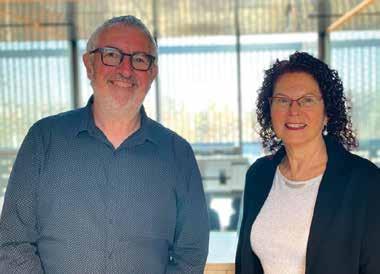
On 27 January, MHM held the annual commemoration to mark International Holocaust Remembrance Day (IHRD) and the liberation of Auschwitz. This year’s theme was the Fragility of Freedom. Nina Bassat AM spoke about the importance of democracy and our three panellists Dr Daniel Heller, Nyadol Nyuon OAM and Dr Kylie Moore-Gilbert also explored this theme in a riveting discussion moderated by Dr Breann Fallon. You can watch the IHRD 2024 event in the past events section on this link: mhm.org.au/events
On another note, we were delighted to wish Holocaust survivor Andy Factor OAM a very happy 100th birthday earlier this year.
We say thank you and goodbye to our former CEO Jayne Josem who has been an integral part of the MHM for over two decades. Thanks to her leadership, we have opened a world-class museum to the public. Welcome to our new CEO Dr Steven Cooke who brings a wealth of experience to the role.
We look forward to seeing you at our new museum. Chag Sameach,

It is with a profound sense of honour and responsibility that we extend a heartfelt welcome back to each of you into our newly redeveloped and recently opened MHM. This moment represents not just the culmination of years of dedicated effort and commitment but also marks a significant milestone in our collective journey of education, remembrance and preservation.
In the wake of 7 October, the role of Holocaust education within our community has never been more important. The rise in antisemitism has starkly reminded us of the vital necessity to understand our history, and ensure that the lessons of the past are deeply ingrained in our collective consciousness. Our museum serves as a beacon of light in these difficult times, offering a space for reflection, learning, and engagement with the history that shapes our identity and values.
The Holocaust offers us invaluable lessons on the consequences of hatred, the importance of tolerance, and the imperative to safeguard our rights and freedoms. Through the museum’s exhibitions, we endeavour to create a dialogue connecting the past and the present, encouraging visitors to reflect on the relevance of these lessons in today’s world.
Let us come together to honour the memory of those we have lost and continue to educate with understanding and empathy. Our museum is not just a repository of history, it is a testament to our resilience, a source of our knowledge, and a foundation for our future.
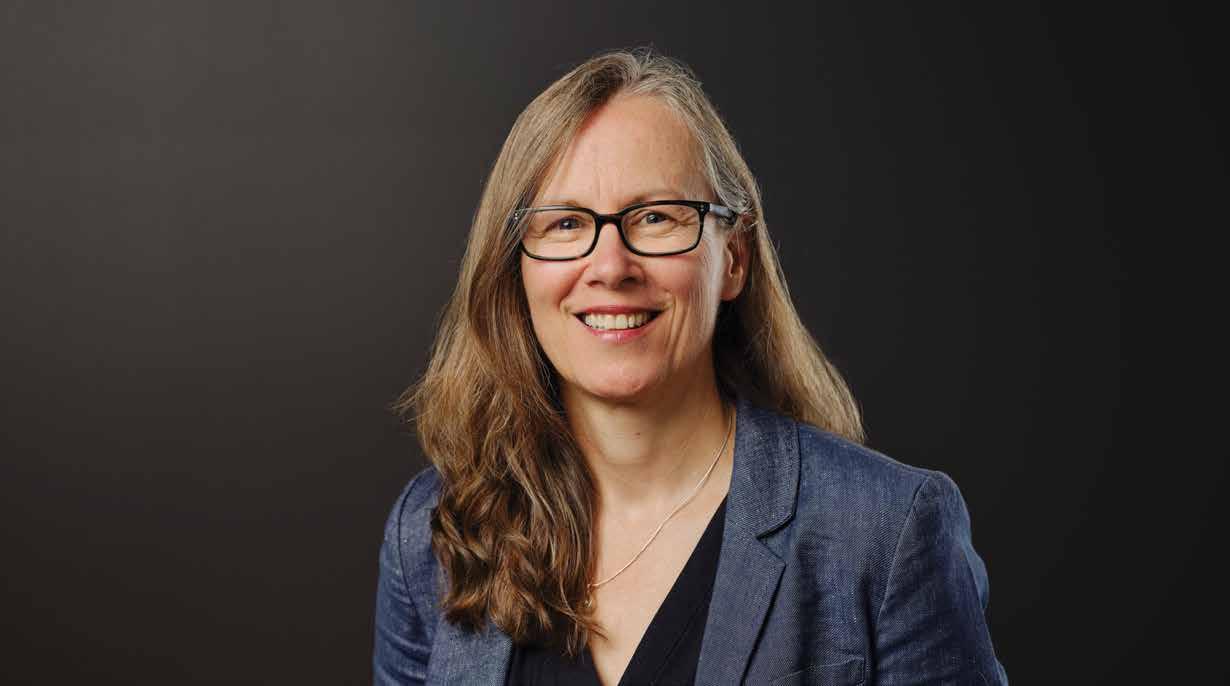
It’s difficult to say farewell to such a wonderful leader. Jayne Josem has expertly steered the MHM towards a new and exciting chapter over the past six years as CEO.
Jayne started at MHM as a volunteer back in 1997, working with Holocaust survivor Phillip Maisel OAM z”l on the Testimonies Project, then with Saba Feniger z”l in the Curatorial Department. In 2002, she officially became an employee at the museum working alongside five survivors to foster Holocaust education and remembrance through a range of fascinating exhibitions.
For Jayne, it’s always been about the survivors. Her work embodies our mission statement – We exist to amplify the voices of Holocaust survivors as a catalyst for greater understanding and acceptance of difference, to inspire a better future
Jayne has achieved so much during her time at MHM. One project that stands out is the Walk with Me survivor immersive testimony VR experience. To create this VR film,
Jayne took Holocaust survivor John (Szaja) Chaskiel OAM z”l back to his hometown in Poland, where Szaja bravely shared his experiences, from his time growing up before the war, to his life in Melbourne as a proud zaida. This outstanding 18-minute VR film eternalises Szaja’s story and explores his resilience, bravery and his love for family. With Szaja having passed away in late 2023, this project is a remarkable legacy to leave behind.
In 2018 Jayne commenced her position as CEO and led a major redevelopment project, of which we are eternally grateful.
We thank Jayne for her vision, perseverance and dedication to our museum over the last two decades. In recognition of Jayne’s contribution we have dedicated an annual lecture in her name, based around the theme of intercultural
understanding. Jayne has given so much of her time to MHM, bringing together different communities in her passion for human rights, and we believe these annual lectures will be an appropriate legacy. Keep an eye out for more information on this in the near future.
On behalf of the MHM Board, we wish Jayne much success in her future endeavours. We know that Jayne’s connection with our wonderful museum will be indelibly printed on her heart and soul and we look forward to welcoming Jayne to our functions and events. Thank you Jayne!
Co-Presidents Sue Hampel OAM and Mike Debinski OAM
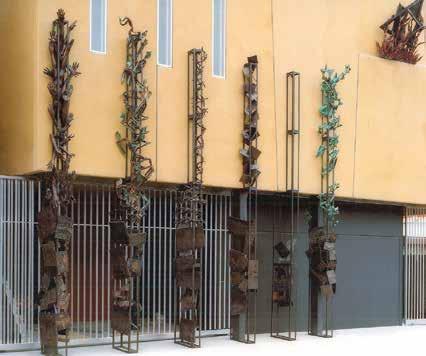
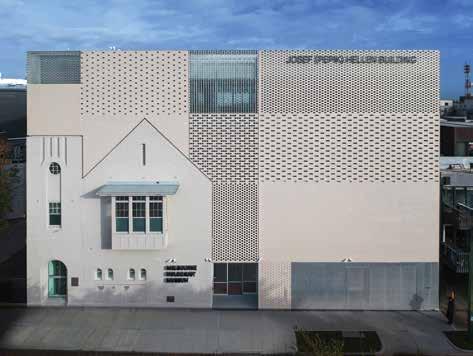

Novelist, screenwriter, and playwright, Elliot Perlman is the bestselling author of Maybe the Horse Will Talk, The Street Sweeper, Seven Types of Ambiguity, The Reasons I won’t Be Coming, and Three Dollars. He is also the author of two novels for children. His work has been translated into numerous languages, adapted for film and television, and published to international acclaim.
The French literary journal, Lire, described him as “the classic of tomorrow” and “one of the 50 most important writers in the world.”
I was 19 years old when I first came to what was then known as the Jewish Holocaust Centre (JHC) having read in the Jewish News that our community, the Melbourne Jewish community, was taking the initiative to open its own Holocaust museum in Selwyn Street, Elsternwick.
Historically, the creation of communal institutions is something that we, Jews, have excelled at. As soon as we arrive somewhere, no matter how few of us there are, we start the process of organising and building institutions to make things easier for those next to arrive. And we are always arriving somewhere because for thousands of years we have been continually fleeing something or someone. The phenomenon that has led to our flight is what might be thought of as a social virus, an example of xenophobia par excellence, antisemitism, the negative discriminatory treatment of Jews as Jews on a factually unwarranted basis. It’s a virus that no society can ever quite entirely rid itself of, a societal illness that curiously, at least in its transmission and in its virulence, has nothing to do with us. Jews are not its cause. They are just the ones who suffer its consequences. It is its stubborn refusal to fade away, its ubiquitousness, and its quite astonishing capacity to adapt and bizarrely mutate, thriving in whatever circumstances currently prevail – permitting, for example, Jews to be seen simultaneously as seditious Bolsheviks and rapacious capitalists – that leads antisemitism, though
by Elliot Perlman Novelist, screenwriter and playwrightan outstanding example of xenophobia, to be, in fact, a unique phenomenon in the psychopathology of the human species. And all of this despite Jews constituting just 0.2% of the earth’s population.
And the most extreme example of antisemitism in Jewish history is the Holocaust, the systematic attempt by Nazi Germany and its allies to annihilate the Jewish people, the historical event that this institution was created 40 years ago to commemorate and to educate people about.
So 40 years ago I rang around all my friends trying to find someone who would come with me to the opening, an event that would mark the beginning of my forty year and still ongoing relationship with this institution. I could not find anyone of my 19 and 20-year-old contemporaries to come with me. And I had gone to Mount Scopus.
It was an incredibly hot March day radiating that almost white un-Ashkenazi light in which Australia specialises, a day that was closer to the end of the war than it is to now. I was shy
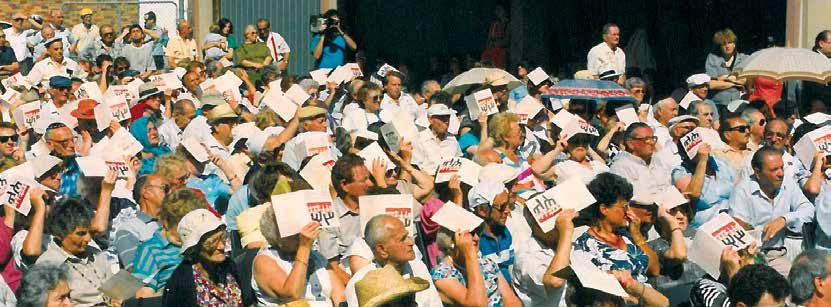

around a community of survivors. I didn’t want anyone to think I was trying to co-opt my people’s tragedy for myself in some kind of self-indulgent adolescent way. When I stood a few feet away from the survivor, Adek Bialik, when he collapsed in the hot sun and died, in a shocking example of tragic irony, I felt that maybe I shouldn’t have come, that perhaps this event belonged to an earlier generation. Why was I there, some 19-year-old interloper? My grandparents fled Poland and Russia before the Holocaust. They lost almost everybody they left behind but unlike so many Melbourne Jews of my generation, I didn’t have parents or even grandparents who were survivors.
I was an aspiring writer of fiction and after the opening of the museum I set myself the writing exercise of composing a short story about the experiences of a young Jewish man in 1980s Melbourne but in the style of the Yiddish master, Isaac Bashevis Singer, and it would include a fictionalised account of my experience of the opening of the MHM (as it is now known). Would it be possible to write something set in contemporary Australia but in the style of I.B. Singer? It was the first adult short story I wrote, and I gave it the name, Spitalnic’s Last Year
Fifteen years later, when it came time for my editors to choose stories from among the various stories I had thus far written for my forthcoming short story collection, The Reasons I Won’t Be Coming, this first story, Spitalnic’s Last Year, kept making the cut. But since I hadn’t known at the
time of the opening of the museum that my experience of that day was going to inspire me to write a short story, or, indeed, to write anything at all, it’s still fair to ask what I was doing there. What made the 19-year-old me go there by myself that hot day? With the distance of forty years, I think I can now answer that.
I was there because I was brought up to consider the events of those years to be, not simply the most important event in Jewish history, but perhaps the single most important measure of exactly what the human being is capable. If you really want to study the human being, you cannot do better than study the Holocaust. Everything you need to know about humans you will find there; cruelty, savagery, the base use of ingenious technology, and of meticulous bureaucratic planning down to the tiniest detail for the sole purpose of mass murder, the sickening need of individuals to conform, the frighteningly limitless capacity for denial and for hypocrisy, but also the capacity for tenderness, kindness, bravery, the remarkable will to survive, and the stunning, breathtaking impulse to recreate – it’s all there. And my upbringing had given me the compulsion then, as I was to write 30 years later in my novel, The Street Sweeper, to tell everyone what happened.
It can often feel, especially recently, that the task of fighting antisemitism is so daunting as to be overwhelming and, as you’re assaulted by examples of it in your daily life, one simply doesn’t know where to start. From here it’s easy
to fall prey to a paralysis of hopelessness and a kind of learned helplessness.
But it’s helpful to remember, first, that while antisemitism is sadly unlikely ever to be entirely eradicated, for diaspora Jews to be largely free of its very worst effects, it needs to be eradicated only to below a certain critical tipping point. From here it’s not impossible to imagine that under the right circumstances (these circumstances being perhaps better left for another essay) there could be a reduction of the viral load below antisemitism’s most dangerous tipping point. This really is achievable. Second, it’s salutary to remember that not all antisemites are equally virulent or committed to their antisemitism. Additionally, there is a substantial category of antisemite containing people whose antisemitism is based solely on ignorance. For this type of antisemite, education with respect to Jews and Jewish history can be (and yield literally) a breath of fresh air. Because of the foresight and incredible hard work of a group of Melbourne survivors forty years ago, this state has the outstanding educational and cultural facility purposebuilt to engage in that vital education.
I can’t get people to take a history degree majoring in Jewish history or the Holocaust. I can’t get them all to read The Street Sweeper or, indeed, any particular book on the Holocaust, but I can often get people to visit this remarkable museum and to absorb its story and its message for as long as they choose.
It can often feel, especially recently, that the task of fighting antisemitism is so daunting as to be overwhelming
Ever since the publication of The Street Sweeper, people have continually asked me, including in Germany, how one fights antisemitism. Indeed, the question has been asked so often that I’ve managed to reduce the answer to just five words. How do you fight antisemitism? One person at a time. The task is urgent and not everyone is equipped to do the job adequately. But fortunately, we are - all of us - able to direct people to the MHM. One person at a time.
©
Elliot Perlman 2024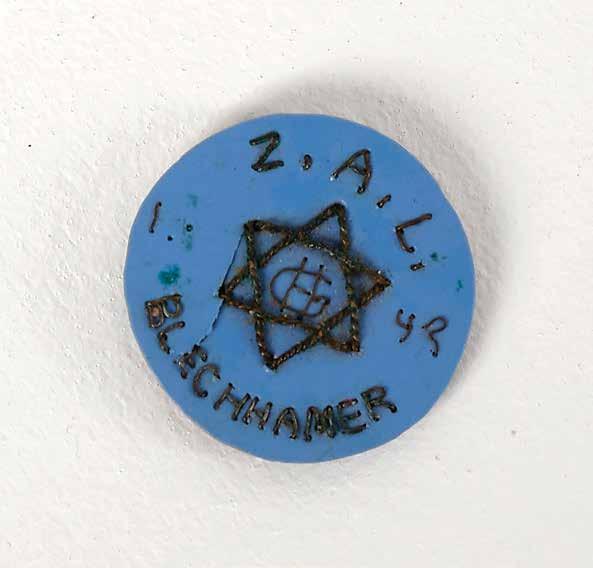
this tragic history.
• Through understanding the humanity in history, the exhibitions would provoke a sense of empowerment and inspiration in people that would extend well beyond their visit to MHM.
So how did we achieve this throughout our exhibition spaces? The humanity is in our survivor’s personal stories. Our exhibition spaces were carefully
experiences with an emphasis on several character strengths to provide visitors with an understanding of the importance of their individual choices.
One of the Holocaust survivors featured in the exhibition is Paul Grinwald. In 1942, Paul, his sister Suzanne and mother Malka, were warned by French policemen not to stay home at their apartment in Paris on 16 July. With nowhere else to turn,

Above: Family engaging with Paul Grinwald’s story in the Hidden exhibition.
Within the Rights Removed gallery of our Everybody Had a Name exhibition stands a display of items on loan from Walter Glaser and his family. The items symbolise their unique story of survival and the kindness of strangers.
In 1938 Dr Johann (Hans) Glaser, his wife Henrietta and son Walter (known as Igo) were desperate to leave Austria. Remembering that a relative with the family name of Borer had settled in Australia, he wrote to all the “Borers” in Australia.
This conscious act of kindness and bravery from the concierge saved the lives of Paul and his immediate family.
Throughout the stories of the seven children in hiding, visitors engage with these moments of humanity to empower them with a sense of agency over their choices and how they impact the world today.
One recipient was Fred Ashworth, owner of a pest control service in Melbourne, the Borer and White Ant Extermination Company. Although they had no relation to the Glaser family, Fred and his friends, the Dacomb sisters, were so distressed by Johann’s frantic plea that they supported the permits for the Glasers and other family members to settle
by Meg Hibbert Communications & Marketing Specialistin Australia. This act of compassion saved the Glaser family and allowed them to rebuild their lives far away from the ensuing war.
Creativity and dignity in the camps
Under the Nazi regime, the Jewish population were further dehumanised in the camp system when their names were stripped from them and replaced with numbers.
Under these conditions, maintaining a sense of humanity was almost impossible. Within the Freedoms Lost gallery of our Everybody Had a Name exhibition, we showcase some ways in which individuals maintained a sense of identity and dignity by creating small items, such as jewellery from metal offcuts.
One of the artefacts on display is a badge made by Marysia Rosenzweig in 1942, in Blechhammer camp, Germany.
Marysia made this badge for her best friend Gucia Honigman (later Ferst). We might understand this act as a desire to retain identity, humanity and friendship while subjected to dehumanisation under the brutal camp system. It stands as a symbol of the small ways human connection can endure in the most difficult times.
We hope our visitors will see reflections of themselves in these small moments of humanity and feel inspired to consider the influence our actions have on our collective future.
Photographed by Mel Desa. Opposite: Badge made by Marysia Rosenzweig in Blechhammer camp, Germany, 1942. From the MHM Collection. Photographed by Simon Shiff.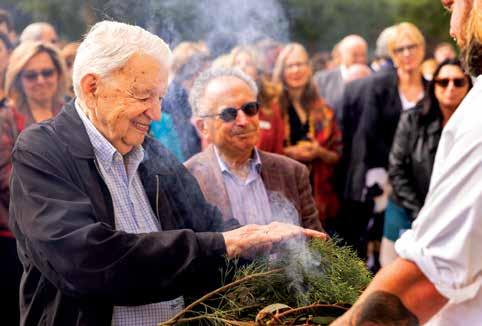
smoking ceremony.
AsHolocaustsurvivors,communityleadersand politiciansgatheredatthefrontoftheMHMonthe morningof22November2023,excitementand anticipationfilledtheair.Itwasawarmmorning; perhapsnotaswarmasthehistoricopeningof1984, butwarmenoughforthestaffoftheMHMtoregret notaddingsunscreenintotheeventproforma.
TheeventbeganwithasmokingceremonyledbyJaedenWilliams, aYalukitWillammanoftheBoonwurrunglanguagegroup.Jaeden captivatedthecrowdwiththeknowledgeandloveheespoused whentalkingofhiscommunity’straditionswhichheshared graciouslywiththeaudience.Jaedeninvitedgueststoparticipateina smokingceremonytocleansetheirspiritsbeforewalkingintothe museum.Beforeenteringthebuilding,RabbiRalphGenendeOAM sharedapoemandabeautifulprayer.
by Meg Hibbert Communications & Marketing SpecialistMizmor Shir Chanukat HaBayit
A prayer for this house of memory
May your doors bring in minds that will learn and grow
Hearts that will feel and expand
Souls that will nurture and soar
May your gates burst open and spill into the streets your stories of courage and compassion
Your tales of dignity and the lovely colours of our differences
Your conviction that remembrance brings redemption
humanity heals a wounded spirit
And generosity grows in the broken bones
That hatred only hurts and festers
That love is stronger than death
That light lingers and gently insinuates itself into the shadows and shrouds
In this house of memories we will let the light in
From this house of memory we will let the light flow out.
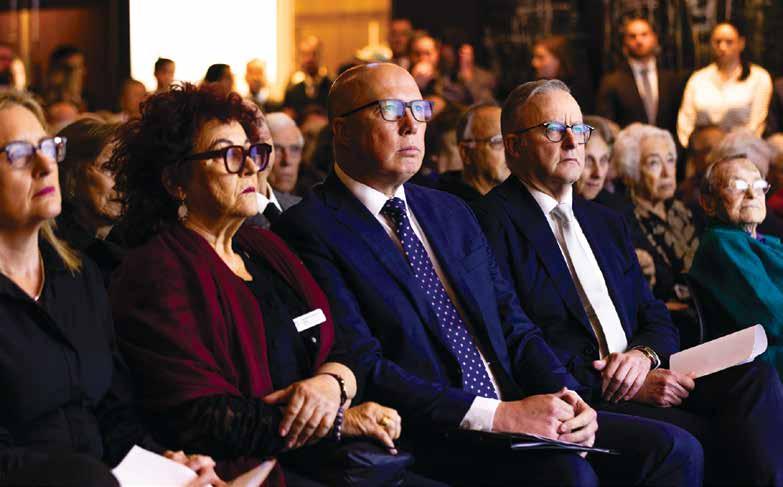
Although the building had been partly operational for almost a year, as the crowd made their way over the threshold separating the MHM and the street, there was a sense of new beginnings; after an almost five-year redevelopment project, the MHM was entering into a new era of education, remembrance and preservation.
Within the Smorgon Auditorium, the atmosphere was lively and spirited. The formal proceedings began with an address from Senior Custodian of Boonwurrung Country Caroline Martin, who, carrying on from her son Jaeden’s introduction, provided the crowd with an exceptional insight into the importance of sharing our community’s narratives, and acknowledged William Cooper and the incredible support local Indigenous communities have shown the Jewish community.
Themorning’sprogramwas comprehensive,withpoliticiansand dignitariesexpressingtheirsupport ofthemuseum’sopening,including thePrimeMinisterofAustraliatheHon AnthonyAlbaneseMP.Albanesewas joinedbyLeaderoftheOppositionthe HonPeterDuttonMP–symbolising bipartisansupportofMHM’smission.
Themosttouchingspeechinthe morning’sprogramwasdeliveredby HolocaustsurvivorAbramGoldberg OAM,whohasbeeninvolvedwiththe museumsince tsestablishmentin 1984.Abramremindedthecrowd whyMHM’smissionismoreimportant thanever.
FollowingonfromAbram’sspeech, thePrimeMinisteraddressedthe crowdwithaclearmessageof understandingandsupportforthe museum’smission
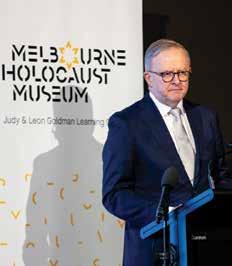 Holocaust survivor Paul Grinwald participating in the
Above:
The Hon Anthony Albanese, The Hon Peter Dutton and Pauline Rockman OAM in the front row at the grand opening of MHM.
Below:
The Hon Anthony Albanese delivering a powerful speech to the crowd.
Holocaust survivor Paul Grinwald participating in the
Above:
The Hon Anthony Albanese, The Hon Peter Dutton and Pauline Rockman OAM in the front row at the grand opening of MHM.
Below:
The Hon Anthony Albanese delivering a powerful speech to the crowd.
It is my great pleasure to be here to witness the opening of our wonderful world-class museum. It is a beacon of light especially in these testing and trying times.
It is a symbol of hope for the future generations, a guiding light for tolerance and a bastion in the fight against antisemitism and racism raging in our society and the world.
At 99 years of age, I never thought we would be faced with such virulent antisemitism in our wonderful country. We must stand up against it. Our voices need to be heard and the voice of reason needs to be heard.

Within its walls, quiet dignity co-exists with awful truths, each one of them giving meaning to the words we keep repeating: Never again.
Those are words that stand on the foundation of memory.
But memory must be a conscious act – as this museum is. Like a flame, memory must be carefully tended and nurtured. And it must be passed on.
Then consider the contribution that generations of Jews have made to Melbourne, the city that is home to the highest per capita population of Holocaust survivors outside Israel. Acts of philanthropy, humanity and generosity, all driven by a powerful instinct to elevate and expand the life of this great, multicultural city.
by Meg Hibbert Communications & Marketing SpecialistAs a survivor of the worst humankind can inflict on each other I am proud to see the memories of the six million souls who were murdered by the Nazis be enshrined and their voices need to be heard as often as possible.
Let me quote our mission statement: ‘We exist to amplify the voices of Holocaust survivors as a catalyst for greater understanding and acceptance of difference, to inspire a better future...’ I have been here since the very beginning, nearly 40 years now and still talk to students every week. This is to honour the memory of my murdered family and to keep a promise I made to my mother in her last moments on the selection ramp in Auschwitz: ‘Abram you should do everything humanly possible to survive and when you do you must tell the world what was done to us’.
I wish the museum and all who work and volunteer here the best for the next 40 years.
Let us be the voice of reason in these troubled times and stand up against antisemitism and racism wherever it rears its ugly head.
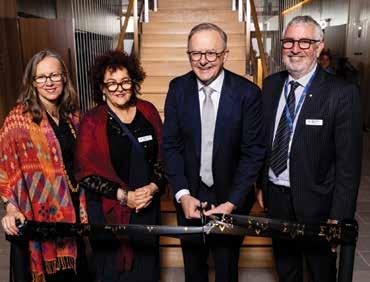
My government is acting to make it clear there is no place in Australia for symbols that glorify the horrors of the Holocaust. And there is no place for those who seek to profit from the trade in these evil symbols, or use them to promote their hatred.
We owe it to our multicultural society, our Jewish community, and our survivors.
I t urn to the words of Holocaust survivor Peter Gaspar, who lost 40 members of his extended family. And I quote: The Holocaust didn’t start with gas chambers and murders and executions. It started with stereotyping, prejudice, discrimination, hate speech …
Those are words to heed. Every day.
What the Holocaust museum so powerfully reminds us, is that when we maintain meaningful contact with the past, we give ourselves our best chance of ensuring it doesn’t become our future.
To make the words ring true as we repeat them: Never again.”
Prime
The Prime Minister’s powerful speech was followed by a ribbon cutting marking the MHM officially open to the public.
Holocaust survivor Abram Goldberg OAM addressing the crowd. From left: Jayne Josem, Pauline Rockman OAM, the Hon Anthony Albanese, Mike Debinski OAM. HolocaustsurvivorAbramGoldbergOAMWhat is your connection to the MHM?
I have been connected to the MHM for many years. In 2012 I started working with Dr Donna-Lee Frieze from Deakin University on a history of the then Jewish Holocaust Centre, which was published in 2015 as The Interior of our Memories. As part of the project, we interviewed people who had been involved with the museum for many years. We talked to them about their motivations and commitment to remembrance. I was also involved in the exhibition redevelopment committee which advised on our new permanent exhibition: Everybody Had a Name. I started as the new CEO in late January 2024, talking over from Jayne Josem. Huge shoes to fill!

What do you hope to contribute to MHM?
I’ve been involved in Holocaust education, remembrance, and research for 30 years now, including enhancing our national and international networks though my role on the Australian delegation to the International Holocaust Remembrance Alliance. I have also written extensively on Holocaust testimony, education, exhibitions, and memory. I also bring to the MHM significant experience of the broader museum context and have worked in leadership positions with the National Trust of Australia (Victoria) and the Shrine of Remembrance and taught the next generation of museum professionals through my work at Deakin University. My role as CEO is to make sure we are an effective and sustainable organisation that remains the finest memorial to the victims of the Holocaust and that staff and volunteers have what they need to continue and develop this work.
What’s your favourite Holocaust-related book or film?
Can I have more than one? The book that started me on this journey was James E. Young’s The Texture of Memory: Holocaust Memorials and Meanings (1993). It is beautifully and clearly written and was one of the first books to provide an analysis of the work that Holocaust memorials do. Young examines their origins and histories, and how they have changed over time, showing how memorials both reflect and shape our understanding of the Holocaust. I would also choose Holocaust survivor Kitty Hart Moxon’s Return to Auschwitz first published in 1981. I had the honour of visiting Poland with Kitty in the 1990s and hearing her share her experiences was life changing.
For all gifts in Will or general fundraising enquiries, please contact donate@mhm.org.au
Our sincere gratitude and appreciation to all our donors and funders — your support continues to allow us to preserve Holocaust memory and teach the important lessons of the Holocaust.
Below are donors of $1000 and above from January to December 2023.
Michael & Helen Abeles
Dion & Sandy Abrahams
Gary & Suzanne Adler
Roseanne Amarant
Jeffrey & Sue Appel
Evan Arnott
Cheryl Baer
Daniel Baker
David Bardas
Andrew & Natalie Bassat
Robert & Nina Bassat
Paul & Sharon Bassat
Judy Becher
Simon Benjamin
Sam & Helen Berkovic
Garry & Sigalit Berkovic
Miriam Berman
Besen Family Foundation
Greg & Julie Blashki
Barry & Lorraine Bloom
Norman & Pauline Bloom
Rosetta Bloom
Joey & Julie Borensztajn
Philip & Vivien Brass
Gary Braun
Judy Braun
Evelyn Bresner
Jon Briskin
Henry & Brenda Buch
Hymie & Eva Bugalski
Isaac & Marilyn Bugalski
Laura Burd
Leon & Tania Burstin
Joe & Pam Bursztyn
Bernard & Helen Carp
Harry Chojna
Jack & Anna Chrapot
Trevor & Heather Cohen
The Copland Foundation
D S Capital
Tom & Evelyn Danos
Siãn Darling
Sid & Elaine Davidoff
Shirley de Winter
Simon & Lisa de Winter
Peter & Kim de Winter
Michael Debinski
Maurice & Vivien Dobia
Andre Dubrowin
Colin & Debbie Edwards
Jack Ekstein
Erdi Foundation
Marjan Erlanger
Shaun & Michelle Factor
David & Vanessa Fajnkind
Sue Fajnkind
Bill Fayman
Ian & Yvonne Fayman
Josh & Abigail Fayman
Marvin & Barbara Fayman
Simon & Amy Feiglin
Mark & Frances Feldschuh
Helen Feniger
Barbara Fih
Alan & Elizabeth Finkel
Michelle Fleischer
Joe & Glenda Flinkier
Ronit Fraid
Peter & Anita Frayman
Tab & Eva Fried
Vivienne Fried
David Fry
Norman Fryde
Gandel Foundation
Mark & Judy Gandur
Jonathan Gavshon
Harry & Helen Gelber
Jack & Gita Ginger
Rachel Goldberg
Graham & Deborah Goldsmith
Deidre Goldstein
Alan & Pam Goldstone
Colin & Debbie Golvan
George & Naomi Golvan
Michael Gonski
Vicki Gordon
Tom & Jenny Gorog
George & Hani Greenberg
Justin Greenstein
Louis & Marilyn Gross
Michael Grossbard
Irene Gruber
Robert Gunsberger
Ed & Ada Gurgiel
Michael & Karen Gutman
Dennis & Suzanne Hain
Harry Hakman & Vivien Wertkin
Brian & Natalie Hamersfeld
David & Lilly Harris
Gary & Sue Hearst
The Family of Josef Hellen
The Henry & Cecilia Foundation
Nan Herzberg
Richard Hogg
Sam & Jacky Hupert
Michele Huppert
Gideon & Judy Ifergan
Paul & Susan Ivany
Lewis & Linda Janover
Vernon & Sandra Jedwab
Stephen & Lisa Jolson
Jayne Josem
Charles & Leah Justin
Steven & Romy Katz
Ashley Kausman & Lisa Mann
Andrew & Judy Kaye
Ken Keyser
Leonard & Yael Kipen
Michael & Esther Kister
Arthur & Marianne Klepfisz
Ken & Carol Klooger
David & Bindy Koadlow
Otto Kohn
Steven & Frances Kolt
Bernard & Margaret Korman
Andrew & Michelle Kornberg
The Family of Jack & Ada Kornhauser
Larry Kornhauser
Alan & Roxanne Kozica
Wendy Kozica
Krakow Memorial Committee
Rachel Kramer
Joe & Marcia Krampel
Dinah Krongold
John & Susan Lamovie
Barry & Barbara Landau
Mark Landau
The Landman Foundation
Henry & Janette Lanzer
Silvana Layton
Robert & Dusia Lefkovits
Rob Lehrer & Melissa Castan
Leibovich Families Foundation
The Lenga Family
Charitable Fund
Shirley Lesh
Ashleigh Levett
Michael Levick
Mark & Anna Levin
Rosie Lew
Ann Lewin
Phil & Sue Lewis
Ryan & Naomi Lewis
Bori & Helen Liberman
Rena Lipton
Michael Ludski
Karin MacNab
Arnold & Dani Mahemoff
Jeffrey & Helen Mahemoff
Bernie & Joyce Marks
Talya Masel
Ezra May
Barbara Michaels
Richard & Melissa Michaels
Adam Micmacher
Henry & Natalie Miller
Quentin & Amanda Miller
Shaun Millett
Marcel Mittelman
Mark & Den Montag
Mark & Sidra Moshinsky
Richard & Romy Moshinsky
Jon Moss
Sid & Fiona Myer Family Foundation
Sidney Myer Fund &
The Myer Foundation
The Nossbaum Family
Raymond & MaryLou Orloff
Tom Osborn & Judy Rassaby
Avi Paluch
Tamar Paluch Ben Zeev
Sam & Ruth Parasol
Gerald & Lil Pearce
Pengana Holdings
Gary & Stacy Pianko
Pincus Family Foundation
Henry & Marcia Pinskier
Phillip & Silvia Piorun
Norman Pollack
Pratt Foundation
PSN Family Charitable Trust
Ian & Sandy Raizon
Wolf & Dora Rajcher
Memorial Fund
Michael & Judy Raleigh
Garry Ramler
Eli & Lorraine Raskin
Lili Recht
Sam & Glenda Recht
Ralph & Ruth Renard
Hedy Ritterman
Pauline Rockman
Andrew & Judy Rogers
John & Margot Rogers
Myron & Jennie Rogers
Annie Rose & Andrew Lazar
Foundation
Jack & Annette Rosen
Harry & Viv Rosenberg
Lance & Julie Rosenberg
Julian & Vivien Rosenfeld
Greg & Anne Rosshandler
Mourice & Ruth Rostkier
Athena Rozenberg
Ben Rozenes & Laini Liberman
Henry & Janette Rubin
Robert & Sue Russell
Adam & Yoko Ryan
Denise Sadique
Ron & Cynthia Salter
Ronald & Kay Schweitzer
Sidney & Julia Segal
Leon & Viv Serry
Danny Shafar
Katie Shafar
Linda Shelton
Alan Sheppet
Kane & Natalie Siegel
Ben & Judy Siegel
Jack & Lesley Silberscher
Eric & Annie Silver
Mervyn & Rae Silverstein
Stephen & Sharron Singer
Michael Sirmai Foundation
Adam & Monica Slade-Jacobson
David & Tammie Slade
Graham & Mary Slade
The Jack & Robert Smorgon
Families Foundation
The Victor & Loti Smorgon Family Foundation
Sue & Norman Sonenberg
Spotlight Foundation
Peter & Sylvia Stach
Adam Stanley
John Steiner Family Foundation
Bernie Stone
John & Irene Sutton
Theo & Shirley Sweet
Stephen & Debbie Szental
Shoshana Sztal-Mazer
Damien Szwarc
Frank & Miriam Tisher
Mark & Caroline Troski
Leon & Sandra Velik
Vicki Vidor
Victor & Karen Wayne
Sam Webb
Celina Widawski
David & Alison Wiesenfeld
Dennis & Tauba Wilson
Andrew Wirth
Colin & Rosetta Wise
Tom & Linda Wolkenberg
Pauline Wroby
Morry Wroby
Philip & Miriam Zajac
Leon & Miriam Zimmet
Sandra Zwier
Dr Steven Cooke. Photographed by Jon Moss.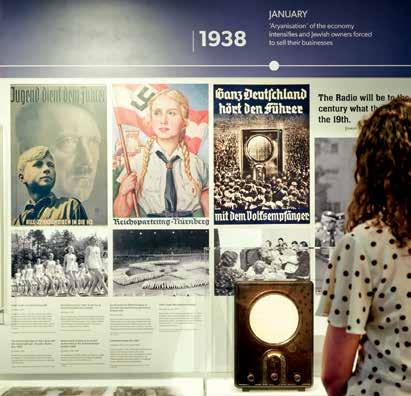
How Holocaust museums have changed since the opening of the Jewish Holocaust Centre in 1984
Having recently marked the 40th anniversary of the MHM in March, we have been provided an opportunity to reflect not only on how we have developed as an organisation but also more broadly on the changes in Holocaust museums around the world. Although the opening of the then Jewish Holocaust Centre (JHC) in 1984 was one of several museums which started in the 1980s, the history of Holocaust museums and exhibitions of course goes back much earlier. Temporary exhibitions in camps like Buchenwald were held immediately after liberation, and the first wave of permanent Holocaust museums in Europe at sites of atrocity started in the decade following the end of the Second World War. Planning for what would become the Auschwitz State Museum started in 1946 for example. Away from the killing centres, the Memorial de la Shoah in Paris opened in 1956, while Yad Vashem was established in Jerusalem in 1957 (although both with antecedents much earlier).

Museums were also established far away from Europe, such as the Los Angeles Museum of the Holocaust in 1961 and the Montreal Holocaust Museum in 1979. 1978 saw President Jimmy Carter establish the Commission on the Holocaust which led to the establishment of the United States Holocaust Memorial Museum in 1993. Although there were silences in families and in public discourse, this did not mean that the Holocaust had been forgotten: rather that memory took specific forms. Many survivors did talk and write about their experiences. In Melbourne for example, the first collection of written testimonies was published in Yiddish in 1946, and temporary exhibitions were held here in 1953, 1961, and 1980. Commemorative events were held yearly, including by individual Landsmanshaftn Motivations for the establishment of the JHC in 1984, the first permanent Holocaust museum in Australia, would be familiar to us today: the rise in antisemitism and racism, the need to educate future generations about the horrors of the Holocaust, and a need for a place where survivors could share their stories.
Harry Redner, quoted in S. Cooke and D. Frieze (2015) The Interior of Our Memories. A history of the Jewish Holocaust Centre, Melbourne: Hybrid, pxi . Emphasis added.
Dr Steven Cooke MHMHolocaust survivor, poet and philosopher Harry Redner wrote eloquently in the commemorative publication for the opening of the centre on what he termed an “ordinary suburban street”: it was a place to “show you what we have carried around for so long in silence and now have deposited in this unlikely place so that you, too, might if you so choose, care for these our mutual relics” . For Redner this was an invitation to a shared ethics. Part of the urgency was a realisation on the part of the survivors who founded the JHC that they would not be around for ever to give their testimony.
For co-founder Bono Wiener, the JHC “was started by his generation of survivors … [but] they would not be the ones to finish this important task”ii. Anxieties about the passing of the survivor generation have been with us since we began.
ii Ibid, p49.
The JHC was, according to the late survivor Helen Light, a heimishe or “homely” place. Over time, exhibitions were updated, the building changed, paid staff joined the volunteers, and survivors passed on the running of the organisation to others. However, they remained at the heart of the museum, either speaking to school groups, sitting on the board, providing wise
counsel, and, in the case of the late Phillip Maisel OAM, running the testimonies project well into his 90s.
Changes of emphasis happened through the exhibitions too. Absent in the first iteration of the JHC exhibition in 1984 were displays related to the history of antisemitism, something that we would see as crucial today. Also missing were panels about survivors themselves. Their stories would filter through all of the displays and they would of course be present to speak to visitors directly about their experiences. The impact

that survivors had in postwar Australia has also grown over time in exhibitions. In part, temporary exhibitions at the JHC as well as permanent displays “To new life” provided a positive narrative of life in a new country: beginning again, starting families, building a home and a career. Obvious in the growing bank of testimonies collected by the JHC and in some of the artwork produced by survivors and displayed in the exhibitions was the ongoing trauma that, for many, stayed with them.
This has now found an explicit place in our permanent exhibit through
Anita Lester’s powerful Noch Am Leben
Holocaust museums and the MHM have also reflected and shaped changes in museum practice more generally. Nowhere is this more obvious than in the increasing importance of testimonies in our exhibitions, echoed by changes in historical practice more generally. From a suspicion of first-person accounts in academic history as subjective, the growth of social history and approaches to oral histories from the 1970s onwards gave increasing legitimacy to
individual narratives. Within the context of Holocaust testimony, not only did the Eichmann trial in Jerusalem in 1961 provide a high-profile platform for survivors to share their experiences, but major projects collecting survivor testimony began in the USA and in Australia in the 1970s and 1980s. We have seen the inclusion of testimony in the museum in different ways. With new technologies came new approaches. Digital technologies allowed the “Storypod” approach in the previous permanent display and now Virtual Reality means that we can “Walk with” the late John (Szaja)
Chaskiel OAM z”l on a journey through Poland and share from his perspective what his family means to him now in Melbourne. We still have many survivors who generously share their time talking with school and other groups. But whilst we may no longer have Chaim Sztajer standing next to his Treblinka model in the museum talking to visitors about his experiences, we have his testimony both in audio-visual form and as embodied in the model itself and in the model of the Old Czestochowa Synagogue.
That there will soon be a Holocaust museum
or education centre in every state and territory in Australia is a testament to the continuing importance of Holocaust education, remembrance, and research. Museums generally are increasingly globally connected with the ability to share information and network databases of collections and testimonies but also to share “good practice”. Organisations such as the International Holocaust Remembrance Alliance (IHRA) facilitate this exchange. Whilst there has been some concern that this might create a uniformity of approaches to memorial culture, what we
are seeing is an increased emphasis on local stories and local connections to the Holocaust. Rather than the Holocaust being seen as long ago and far away, the experiences of the survivors who came to Australia and made their homes here, as well as the numerous other historical connections make the Holocaust a key part of the Australian story. So, rather than being –according to Redner - an “unlikely” place for a museum, perhaps there is no better location to tell the history of the Holocaust which is at the same time both a defining event in world history but also an intensely local
story, than in this “ordinary suburban street”.
Through all the changes since 1984 then, there is a continuous thread that runs through our work. The initial impetus of the founders remains. We are a place where their voices are heard in many ways, where we warn about the dangers of antisemitism and racism, and where all can come and share in the hope for a more peaceful future.
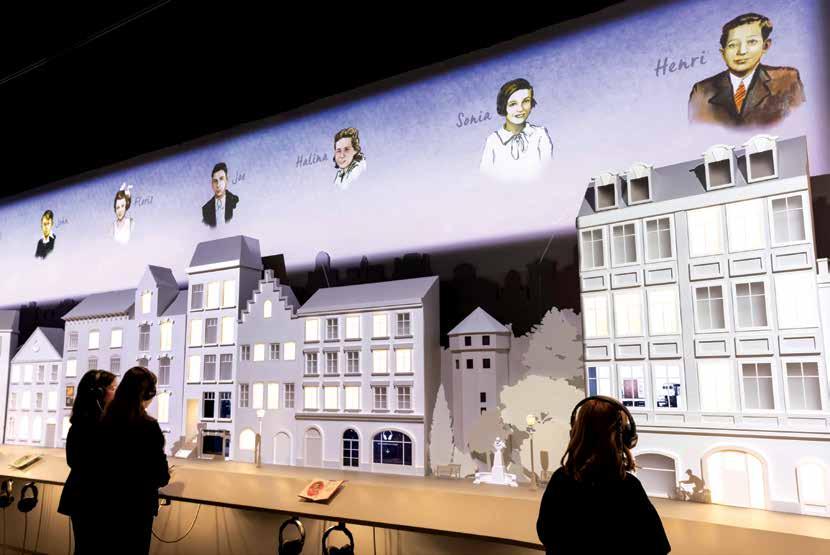
Ariel Efron is the creative director and a group director at Art Processors (AP). He is the head of the group in the US, and the bridge to the AP technology group. Under Ariel’s leadership, the AP team worked with the MHM Curatorial team to develop Hidden: Seven Children Saved.
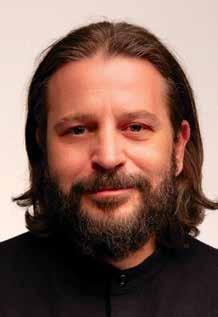
Howwouldyoudescribethis exhibition,Hidden?
IthinkHiddenisajourneydesigned forkids,wherekids,childrenoftoday, meetthechildrenofthepast.Itisa bridgefromlessons earntinthepast throughtothepresentday,butit’s actuallyabouthowwecraftourfuture, whatistrulyimportantandhowwecan learnfromhistory
Whatdoyouthinktheexhibitiontells usabouttheEuropeanJewish diasporahereinMelbourne?
Ithinkittellsthestoryofresilience,of adaptation,ofgettingasecond chance,anopportunitytorewriteyour lifefromtheworstconditionstobe abletocreatesomethingfromnothing. Tobuildfamilies,buildprofessional lives,buildnewcontext.
Thereisasectionintheexhibit whereyouseethateachoneof thosesevensurvivorsflourished, andtheycreatedawholeuniverse ofpeopleandmomentsandplaces andaccomplishments.Itisthepower ofsurvival,notjustinthesenseof stayingalive.It’saboutmakingliferich. AndIthinkthatisthestoryofthose peoplewhomadeittoAustralia,and alsoalotofpeoplewhoreallymadeit inplacesliketheUSorIsrael,tomake themostofthisopportunitythat theyreceived.
What are the factors that really make this exhibition work?
I think that it understands the audiences that it’s trying to talk to. The fact that this museum came with a lot of experience in education and knowing how to really craft a nuanced point of view, how to speak about dramatic events in history, but to find the right angle on how to make history relevant today. The idea that you look at children of the past, but it’s in a way, a mirror reflection of yourself.
You can see yourself in those family photos. You can see yourself fighting with your siblings. You can see yourself helping each other in hiding. You can really identify on very basic human things. That creates the base level of connection of children talking to children in their own language. It’s driven by optimism. It’s honest, it’s simple, it’s eye level. The message is also poetic and beautiful.
Be just, be fair, be aware.
The simplicity of that, the call to action to something so fundamentally basic and positive, is what makes this exhibit so effective.
WhatvaluedidArtProcessors bringtothisproject?
APhasanintellectualaspirationto connectwithcurators,tobeinspired bycurators,andtosurprisethemwith ideas.ThisisamagicalqualitythatAP has.Thereisaverydistinctmastery oftechnology–oftheprojection mapping,themotiongraphics,the animation,thesounddesign–whenweconsiderthisholistic designapproach.
Everyelementispartofanorchestra thatplaystogether,allforthebenefit ofthechildren,theusers,thepeople whowillgothroughthisexhibit.So, APhasahighlevelofunderstanding oftheaudienceswithahighlevel ofexpertiseinmediaanddesign, whichiswhatIthinkmakesusvery, verydifferent.It’snottechnology fortechnology’ssake.Storytelling isembeddedintothechannelsand avenuesthatareavailableforusas designerstoday,asstorytellers.Light, sound,projectionandillustration andexpressiveartblendintothose narratives,intothoseexperiences,and createsaveryimpactfulmomentthat peoplewillcherish.
Peoplewillrememberthevillage. Theywillrememberthatlittle dollhouse.Theywillremember themotivations.
Allofthatmaynothappenwhenthey arehere,butitwillhappenasthey leaveHidden.Andsothatwasthe aspirationandIthinkthat’swhatAP hasdoneinaverysmartway.
Ariel Efron Shiff.
Shiff.
In late 2023, the MHM started offering corporate programs. Delivered to professional groups, these address the principles of cultural competency through the lens of the Holocaust. This program was born of the view that while we want people to engage with the history of the Holocaust, we specifically want them to use what they are learning in order to make this world a better place.
This intention is very much in line with our mission statement: to amplify the voices of Holocaust survivors, not just so that we know what happened in the past, but as a catalyst for greater understanding and acceptance of difference today.
Described as the ability to work effectively across cultures, cultural competency commences with an understanding of one’s own culture. Participants in our corporate programs are given opportunity to reflect on all the different sorts of things that they might take for granted and consider “normal”. That which we consider appropriate behaviour in
public, the importance that we attach to education, the ways in which we speak about our family and our colleagues, the sorts of people to whom we show respect – even the ways in which we show it: these are all cultural values.
Our cultures are determined by our religion (or lack thereof), our nationality, the places from which we or our ancestors came, and even things like gender, sexuality, and age. Looked at in this perspective, we can appreciate the degree to which we are each possessed of multiple cultures, the extent to which culture influences everything about us, and the need to
foster an appreciation for the variety of other cultures with which we might interact on a daily basis.
To date, we have run cultural competency workshops for the Australian Football League (AFL), for Port Phillip Council and for representatives of AJAX, Southern Metro Junior Football League (SMJFL) and the Victorian Amateur Football Association (VAFA). In each of these, we have presented the principles of cultural competency as a preface to an extended discussion around antisemitism. While we all agree that discrimination needs to be stamped out, the peculiar nature of antisemitism is such that it can be difficult to identify, and people who are not Jewish might have difficulty appreciating its harm.
To do this, we provide a brief overview of the history of antisemitism, consider how it is different from other forms of discrimination (by virtue of the fact that it ascribes power, status and
prestige to its target), and we look at the various forms that it takes today. We do this because we want people to understand the particular sensitivities of Jewish people in the 21st century, and to understand the importance of being vigilant against anything that might cause offence.
Importantly, this program also includes a guided tour of our permanent exhibit, Everybody Had a Name. To date, we have also run several corporate programs that include only the tour, since many of the ideas addressed in the workshop can also be tackled (in a condensed format) on the museum floor. It is there that the history of the Holocaust can be imparted to visitors, the better that they understand the experiences of our survivors and appreciate the trigger points and sensitivities of their descendants.
To that end – and as with all our tours –the focus in the museum is one of resilience and endurance. We want
by Dr Simon Holloway Manager of Adult Education & Academic Engagementpeople to appreciate the enormity of what was lost, and we want them to understand something of the horror that was the Holocaust, but we want to do so in such a way that they feel empowered, afterwards, to do something. We do not want them to feel the burden of history but the impulse to action.
It is our hope that corporate tours will take their place alongside other museum programs in helping to create a culture of empathy, to foster greater tolerance and compassion, and to build a better future for everyone.
Dr Simon Holloway leading a tour around the Everybody Had a Name exhibition.In 2023, we completed our MHM Experience Master Plan, mapping out how we wanted visitors to experience the museum from the moment they connected with us until long after they leave. With our museum open to the public for six months now, we are thrilled to receive feedback about our onsite experience from our public visitors and students which reflect these moments underpinning this master plan. Here is some of the feedback we’re receiving in relation to our “moments that matter”.
Moment: A warm welcome
We want our visitors to feel welcome and prepared before they visit our museum.
Moment: Making it personal Moment: My reflection
We focus on the personal stories of our survivors to inspire individuals to drive impact and change in the world.
We hope to inspire little moments of reflection or the grand point of shared understanding that allow us to process it all and make meaning.
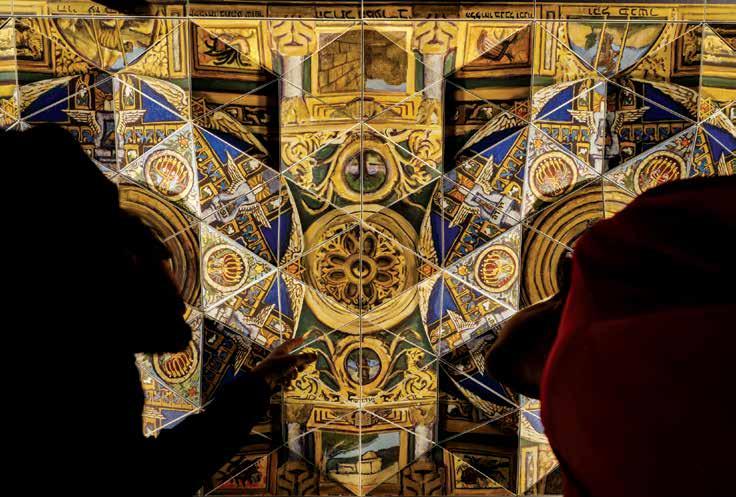
“The building is beautiful, and the staff were incredibly welcoming and forthcoming with personal experiences. We really appreciated the communication with staff. The exhibition itself was incredible. It really provided me with a good understanding of the Holocaust and the experiences of people that suffered.”
“I came thinking that I would leave saddened by my visit but I left feeling uplifted with the friendliness of the staff. Also more informed. Thank you.”
“Really beautiful memorial to a horrific moment in recent history. Everyone was incredibly welcoming and made the experience very meaningful for my friend and me.”
“From the moment we entered, everyone was so friendly and welcoming. There was always someone to help. An incredible space that is both immaculate and thoughtfully designed. The exhibitions were creatively presented and incredibly engaging. I have already recommended to several people. Thank you.”
“The exhibition anchored back to humanity while telling the story of what happened. While you hear about the numbers it’s hard to relate that to individual experiences. This made it very real.”
“I think it honours the survivors who have volunteered at the museum. I found that particularly touching to hear their stories and see their families.”
“I found it very emotional especially as the majority of stories apply to survivors I know in a personal or communal capacity.”
“The Hidden exhibition shows that everyone’s story is different… many people think that everyone had the same story from the Holocaust, but actually everyone’s experiences were very different, so the personal stories were important to learn about.”
“We have to be good to each other as we are all more alike than we are different.”
“The Hidden exhibition is so important... it provides a deeper insight into the lives of those who were affected and how it might still affect us today.”
Moment: Supported by the best
We want to support visitors throughout the journey, providing knowledge and resources when they need it.
“I came to do some research for my thesis. I live in Bahrain. Julia [Information manager & librarian] was amazing and exceptionally helpful. I wish I lived in Melbourne as I would definitely volunteer. Thank you for making me welcome.”
Visitors looking at the Fragments of memories: A reimagining of the Czestochowa Old Synagogue ceiling artwork in the Everybody Had a Name exhibition. Photographed by Simon Shiff.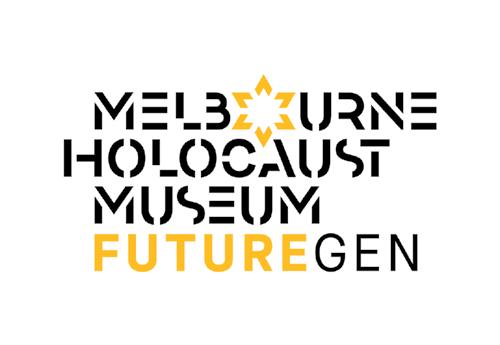
It’s hard to decide which part of the new museum I am most drawn to. It’s a close call between the beautifully understated library, where hundreds of books trace the history of the Holocaust and preserve the haunting memories of survivors, and the digital donor board, which proudly guards the central foyer.
The donor board tells a compelling tale of a different kind: a story of a community that, through ingenuity and tenacity, has prospered in Australia. As I cast my eyes across the board, I silently acknowledge and thank these donors, who over the past 40 years have so generously ensured the continuity of MHM, ever mindful of the responsibility to honour the six million Jewish victims of the Holocaust, to preserve the museum’s precious collection and to educate against hate.
A close inspection of the names also reveals a striking lack of people under the age of 60.
My generation, it seems, has been overly reliant on our elders when it comes to supporting this vital institution.
Over the last year, more than 19,412 students from schools and other education institutions visited the MHM. We are very excited to see this number continue to grow as we plan to welcome more students than ever before.
Aitken College
Alamanda K-9 College
Albert Park College
Alexandra Secondary College
Alia College
Alice Miller School
Alphington Grammar School
Altona College
Ararat College
Ave Maria College
Bacchus Marsh Grammar - Maddingley Campus
Ballarat Christian College
Ballarat Grammar Schools City Cite
Ballarat High School
Balwyn High School
Beaconhills College - Berwick Campus
Beaumaris Secondary College
Belmont High School
Bentleigh Secondary College
Berry Street School
This is the issue that the FutureGen initiative is hoping to address. Our committee plans to harness the excitement generated by the new, award-winning building and the deeply moving permanent exhibitions, to promote engagement with MHM and to ensure it continues to have a profound impact, well into the future.
A new generation has become the custodians of survivor stories. For me, this privilege and the accompanying responsibility has been underscored by the recent passing of my grandmother who was a Holocaust survivor.
FutureGen will support MHM in its quest to amplify the voices of Holocaust survivors and educate about the dangers of antisemitism. I hope everyone will feel inspired to take up the mantle of this important mission at this critical time in our community’s history.
Romy Moshinsky is a memoirist and publisher. She is a proud member of the FutureGen Committee and her business, Real Publishing, is sponsoring the FutureGen launch on 18 April.
Berwick Secondary College
Beth Rivkah Ladies College
Bialik College
Billanook College
Birchip P-12 School
Blackburn High School
Boort District P-12 School
Box Hill High School
Box Hill Senior Secondary College
Braybrook College
Brentwood Secondary College
Bright P-12 College
Brunswick Secondary College
Camberwell Girls Grammar School
Camberwell Grammar School
Camberwell High School
Camperdown College
Carey Baptist Grammar School
Carrum Downs Secondary College
Carwatha College P-12
Castlemaine Secondary College
Cathedral College Wangaratta
Catherine McAuley College
Catholic College Sale
Catholic Ladies’ College
Catholic Regional College
Caroline Springs
Caulfield Grammar School
Caulfield Grammar School Wheelers Hill
Chairo Christian School Pakenham
Chelsea Primary School
Christian College Geelong
Christian College Geelong
Bellarine Campus
Christian College Middle School - Highton
Citipointe Christian College
Clonard College
Cobram Anglican Grammar School
Coburg High School
Columba Catholic Primary School
Copperfield College - Kings Park Junior Campus
Covenant College Geelong
Cranbourne East Secondary College
Cranbourne Secondary College
Croydon Community School
Crusoe 7-10 Secondary College
Daylesford Dharma School
Department of Education
Derrinallum P-12 College
Dimboola Memorial Secondary College
Docklands Primary School
Dromana Secondary College
Drouin Secondary College
East Doncaster Secondary College
Elevation Secondary College
Elisabeth Murdoch College
Elwood Secondary College
Emmanuel College Warrnambool
Epping Secondary College
Essendon Keilor College
FCJ College Benalla
Fintona Girls’ School
Flinders Christian Community College -
Carrum Downs Campus
Flinders Christian Community College -
Tyabb Campus
Gardenvale Primary School
Gilson College Taylors Hill
Gippsland Homeschoolers
Gisborne Secondary College
Gladstone Park Secondary College
Glen Eira College
Glen Waverley Secondary College
Glenroy College
Goulburn Valley Grammar School
Hallam Senior Secondary College
Hampton Park Secondary College
Heritage College
Highvale Secondary College
Hillcrest Christian College
Hopetoun P-12 College
Hoppers Crossing Secondary College
Ivanhoe Girls’ Grammar School
Ivanhoe Grammar School
John Monash Science School
Kalianna Special School
Kambrya College
Kaniva College
Keilor Downs Secondary College
Keysborough Secondary College
Kings Christian College
Koo Wee Rup Secondary College
Koonung Secondary College
Kurnai College
Kurunjang Secondary College
Kyneton High School
Lakeside College
Lalor Secondary College
Lauriston Girls’ School Armadale
Lavalla Catholic College
Lighthouse Christian College
Lilydale Heights College
Lilydale High School
Loreto College - Ballarat
Luther College
MacKillop Catholic Regional College
Macleod College
MacRobertson Girls High School
Manor Lakes P-12 College
Marian College Myrtleford
Marian College Sunshine
Maribyrnong Secondary College
Mary MacKillop Catholic Regional College
Matthew Flinders Girls
Secondary College
Mazenod College
McClelland College
McKinnon Primary School
McKinnon Secondary College
Melbourne Girls’ College
Melbourne Girls Grammar
Melbourne Grammar School
Melbourne High School
Melbourne Montessori School
Melbourne Rudolf Steiner School
Melbourne University
Melton Christian College
Mentone Girls’ Grammar School
Mentone Girls Secondary College
Mentone Grammar School
Merbein P-10 College
Mercy College Mackay
Methodist Ladies’ College
Moama Anglican Grammar School
Mooroolbark College
Mordialloc College
Mount Clear College
Mount Erin College
Mount Lilydale Mercy College
Mount Rowan Secondary College
Mount St Joseph Girls’ College
Mount Waverley Secondary College
Mountain District Learning Center
Mt Hira College
Nathalia Secondary College
Northern College of the Arts and Technology
Norwood Secondary College
Nossal High School
Notre Dame College
Nunawading Christian College - Secondary
Oakleigh Grammar
Oberon High School
Officer Secondary College
Our Lady of Mercy College
Our Lady of Sion College
Overnewton Anglican Community College
Oxley Christian College
Pakenham Secondary College
Pascoe Vale Girls Secondary College
Patterson River Secondary College
Peninsula Grammar
Penleigh & Essendon Grammar School
Keilor East
Phoenix P-12 Community College
Point Cook P-9 College
Prahran High School
Preshil, The Margaret Lyttle
Memorial School
Preston High School
Richmond High School
Rochester Secondary College
Rowville Secondary College
Western Campus
Ruyton Girls’ School
Sacre Coeur
Sacred Heart College Yarrawonga
Saint Ignatius College Geelong
Salesian College Chadstone
Salesian College Sunbury
Scotch College
Seymour College
Shelford Girls’ Grammar
Shepparton ACE Secondary College
Sholem Aleichem College
Simonds Catholic College
Somerville Secondary College
South Oakleigh Secondary College
St Albans Secondary College
St Andrews Christian College
St Bede’s College
St Bernard’s College
St Catherine’s School
St Joseph’s College Echuca
St Joseph’s College Ferntree Gully
St Joseph’s College Geelong
St Leonard’s College Brighton
St Margaret Mary’s College Townsville
St Margaret’s Berwick Grammar
St Mary MacKillop College
St Mary of the Angels Secondary College
St Mary’s College Seymour
St Matthew’s Primary School
St Michael’s Grammar School
St Patrick’s College
St Philip’s Christian College Waratah
Star of the Sea College
Strathcona Baptist Girls’ Grammar
Sunbury College
Sunbury Downs Secondary College
Sunshine College West Campus
Sunshine College, North Campus
The King David School
The Lakes at South Morang College
Tintern Grammar
Trinity College Colac
Trinity Grammar School Kew
University High School
Upper Yarra Secondary College
Upwey High School
Vermont Primary School
Victory Lutheran College
Viewbank College
Wangaratta High School
Warrnambool College
Waverley Christian College - Wantirna South
Wellington Secondary College
Wesley College Elsternwick
Wesley College Glen Waverley
Westall Secondary College
Williamstown High School - Bayview Campus
Wodonga Senior Secondary College (Seymour)
Woodmans Hill Secondary College
Woori Yallock Primary School
Yarra Valley Grammar School
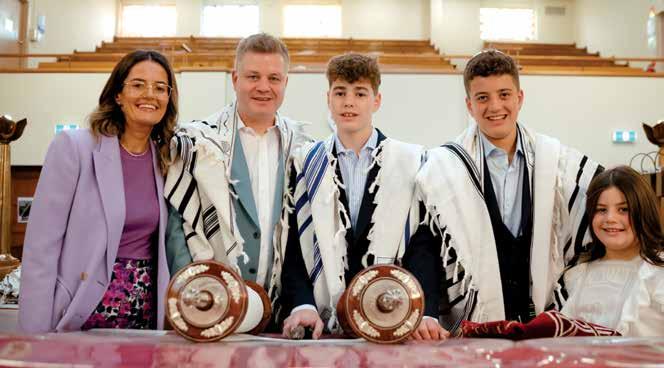
Nate Banky is a Level 8 student at Mount Scopus College. His hobbies range from singing and playing the piano, to jiu-jitsu and cliff jumping. Though Nate’s hobbies are quite exceptional, they are not the most exceptional thing about this young man. What’s most remarkable about Nate Banky is his kind-hearted spirit, and intrinsic desire to inspire a better future.
On the occasion of his Bar Mitzvah in October 2023 Nate Banky made the generous decision to donate his Bar Mitzvah gift to the MHM.
When asked what his connection to the Holocaust was, Nate said:
“My connection to the Holocaust is through my great grandparents. I was lucky to have met my dad’s grandparents - David and Faygie Landau - known to me as Zaida and Bubba Faygie. They both survived the Holocaust after losing so many of their family members. My Zaida wrote a book about his life which I read and found very interesting.”
After Nate visited Yad Vashem in Israel, he was so moved by the experience that he wanted to contribute to a Holocaust institution in Australia. So, on his Bar Mitzvah, Nate took the opportunity to make an impact in the community, by donating an amazing $6,781 to the MHM.
Nate said:
“Now, more than ever, MHM needs support. With the current war, antisemitism has risen dramatically. I see the antisemitism on social media, on the news and I hear stories from my family and friends. The MHM educates people of the horrors of antisemitism. A visit to MHM should be compulsory for all Victorian high school students, to educate people and prevent another Holocaust from occurring.”
The MHM is grateful to have young leaders like Nate Banky to support our continued mission to educate against prejudice, antisemitism, and racism for generations to come.
If you would like to learn more about our Simcha Giving Program, please visit: https://mhm.org.au/fundraise-for-us
Before attending the International Holocaust Remembrance Alliance (IHRA) plenary in Zagreb, I travelled to London and was fortunate to witness a remarkable ceremony at the Wiener Library. The Wiener Library has access to the Arolsen Archives which contain over 30 million paper records testifying to the brutality of Nazi persecution. This collection is part of UNESCO’s Memory of the World. A lesser known part of the archive is a collection of 2,500 personal items stolen from people on their entry into the concentration camp system. One item was a black pen, belonging to Hans Joachim, a chemist living in Dresden until his deportation in 1943 to Buchenwald and Neuengamme. By some coincidence, this precious pen ended up in the Arolsen Archives. Recent research uncovered a relative of Hans living in London and I watched as his great niece received the item, 70 years after it had been confiscated. It was a very emotional ceremony.
Ahead of the plenary meetings in Croatia, delegates were invited to visit Jasenovac Memorial Site and the Roma Memorial Centre Uštica. During this visit, IHRA delegates heard from key personnel involved in creating the two memorials.
The Zagreb Plenary was held against the backdrop of an enormous rise in global antisemitism in the wake of the 7 October Hamas terrorist attacks. Country experts reported a 400-1000% increase in antisemitic incidents. As we know, the war has brought a threat to social cohesion in Australia, and this was discussed by our experts. Holocaust education, remembrance, and research in the wake of the conflict impacted many of the discussions over the ensuing four days.
The meetings coincided with the release of some hostages held by Hamas since 7 October. The Education Working Group (EWG) invited delegates to express solidarity with the hostages, including two Yad Vashem educators, Liat Atzili, who has since been released, and Alex Dancyg who remains in captivity. At the EWG, I gave a presentation showcasing the highlights of our world-class museum.
The Museum and Memorial Working Group (MMWG) heard from a number of museums related to challenges in the wake of 7 October. There was no consistent experience. Some museums have experienced a drop in numbers, particularly school groups cancelling for safety reasons. Others have experienced increased visitation.
Our delegation was led by Australia’s Ambassador to Croatia, Mr Richard Rodgers. A highlight was the official announcement of our new CEO Dr Steven Cooke as the incoming Chair of the MMWG for 2025.
In the shadow of this terrible conflict, we strive for a better tomorrow.
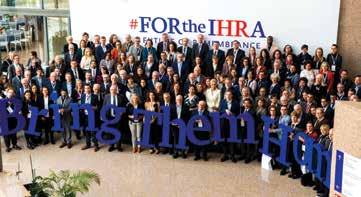 Nate Banky and his family at his Bar Mitzvah.
Nate Banky and his family at his Bar Mitzvah.
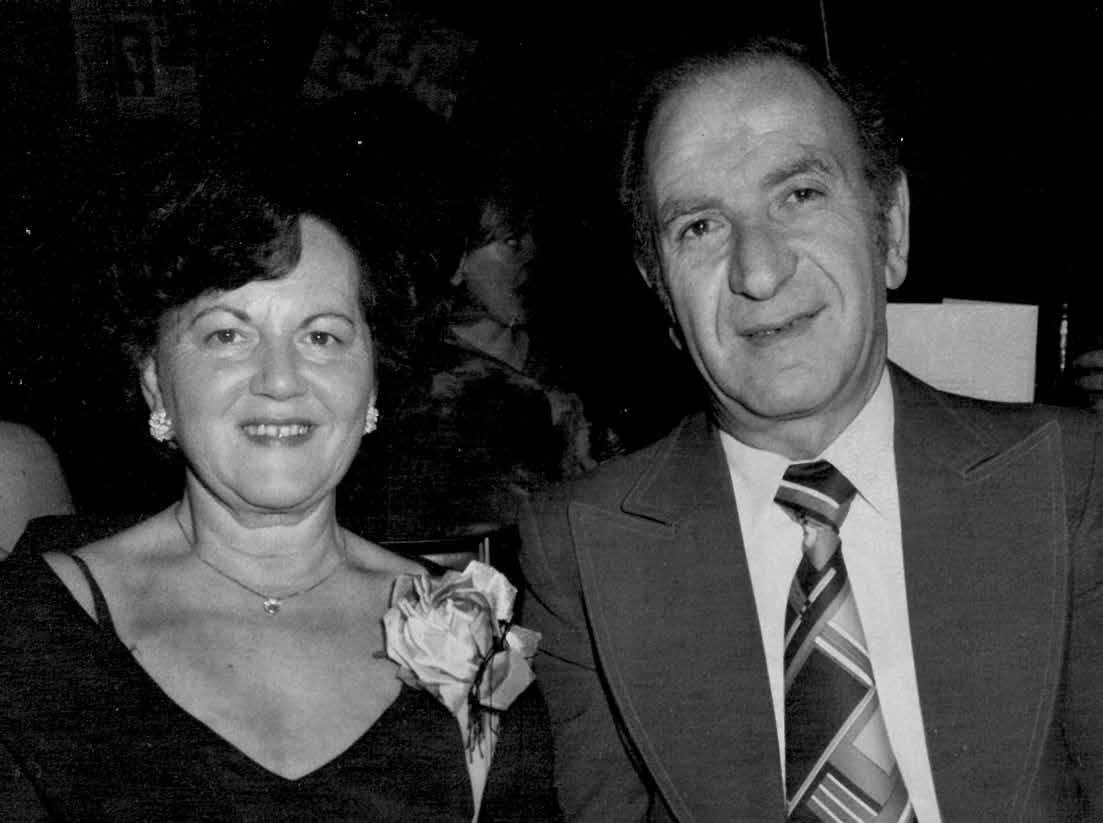
Regina (nee Rajzbaum) was born on 6 May 1928 in Lodz, Poland. She was 11 at the beginning of the war. Pincus was born on 28 October 1919, in Pabianice, a small town just north of Lodz.
Both were the youngest in their respective poor shtetl families. Regina was one of nine children; three siblings survived the war in Russia and Regina survived the Lodz Ghetto and Auschwitz. Regina’s father was a Chasidic teacher in a Cheder. Pincus was one of five children. One survived having left Poland in 1929 to live in France and Pincus survived Pabianice jail, ghetto and concentration camps including Auschwitz and Stutthof. Pincus’ father was a Chasid who sold homewares from his horse and cart.
Regina and Pincus met at a mutual friend’s home in Lodz a few months after liberation and were married in August 1946 in Eggenfelden. Soon after they joined Pincus’ brother in Paris. Their first child Felix (Faivel, named in memory of Pincus father), later, Phillip, was born in August 1947.
After struggling for two years in Paris the stateless Regina and Pincus, with their 18-month-old child, boarded the Luciana Manara. They sailed to Australia - the end of the world, the Goldena Medina, with a few borrowed francs, pots and a sewing machine, arriving at Station Pier, Melbourne on 15 May 1949. They were sponsored by the same mutual friends who had introduced them back in Germany. They were themselves refugees having arrived in Melbourne two years earlier.
Pincus always told us – his children –that day in May 1949 was the happiest of his life and the sun began to shine. From the moment they stepped off the ship they worked hard. Incredibly hard. Five years later their second son, Elek (named for Pincus’ mother, Ethel, and later known as Allan) was born.
Our parents, Regina and Pincus, gave us a traditional Jewish family life, sent us to a Jewish school, celebrated Shabbat every Friday, dressed us in new clothes and took us to Elwood Shul for the Yom Tovim. They
donated to every Jewish charity and organisation. They sent us to Habonim and Betar. Pincus looked forward to reading the Yiddishe Tsaitung every week and attended the Kadima regularly. They taught us about Judaism, to be proud Jews and to stand up for our people.
The Holocaust was a lived experience and touched every aspect of Regina and Pincus’ life. The importance of supporting the JHC, now the MHM, was critical to them. Not just to keep the memory alive but to teach both Jewish and non-Jewish children and adults about the reality of antisemitism. Now more than ever the legacy they have left is so important for future generations.
Those two distraught, refugee survivors who came to Australia some 75 years ago, with only a dream for a safe future, both lived into their 90s and left this earth having created a family of some 17 descendants.
Regina & Pincus (Paul) Grosman Regina and Pincus (Paul) Grosman. Courtesy of the family.In 1984, when the Jewish Holocaust Centre (JHC) was in its infancy, a young survivor by the name of Jack Unikowski worked in the office at Smorgon Consolidated Industries.
As the story goes, Jack, a Buchenwald Boy, approached Victor Smorgon about supporting the new Holocaust museum. Victor went to his family and they decided on a small donation. Jack said thank you, and asked Victor why it wasn’t more. Victor’s response was that the family did not experience the Holocaust. To that Jack responded, “that is precisely why you should support the museum, you were the lucky ones”.
Victor went back to the family and agreed that indeed the family would support the museum by funding their main auditorium.
In 2004, the newly-formed Victor Smorgon Charitable Fund entered a long-term relationship with the MHM Foundation, making annual contributions. We believe our support to the endowment contributes to MHM’s stability and prestige by creating an ongoing and sustainable income stream. A well-managed endowment not only plans for long-term stability, fiscal responsibility, and financial viability, but most importantly it relieves pressure on annual fundraising initiatives. By EOFY in June 2023 the
Victor Smorgon Charitable Fund had contributed over $1 million to the endowment fund.
As we reflect on the past 40 years, we are proud to call ourselves a lifelong supporter of MHM’s mission, with the new redeveloped auditorium still bearing the Smorgon family name.
Jews have been shaped by a history of persecution and expulsions leading to the dispersion of Jewish communities across the world. That too is the history of the Smorgon Family, fleeing Russia’s pogroms in 1927. Jews have faced marginalisation, oppression, and/or horrific violence in every society, and in every era for thousands of years. Recent history has shown us that when violence occurs involving Israel there are spikes in antisemitism across the globe, and when antisemitism is normalised, Jewish safety can change rapidly.
The events of 7 October have brought a rise in hostilities to our community and the work of MHM has never been more important. MHM’s focus on preserving Holocaust memory and educating

on the lessons learnt to address hate, and identify and understand anti-Jewish narratives, is critical.
MHM asks their visitors to consider, speak and to act with nuance and empathy. The museum ignites a sense of humanity in its visitors, empowering champions of kindness, bravery, and fairness.
The Loti & Victor Smorgon Family Foundation supports Jewish communal organisations that foster education and connection to help us think critically and build a stronger, better and more resilient Jewish community.
by the Smorgon FamilyThe new Smorgon Auditorium. With a capacity of 200 people, the auditorium provides a space for the MHM to host an array of thought-provoking events and meaningful commemorations.

Szaja, a father, a zaida, a great zaida, a partner, an uncle, a friend, a Buchenwald Boy, and a survivor.
Szaja was a loyal, dedicated and committed volunteer at the MHM for over 25 years.
His work at “The Holocaust” (as he and his survivor friends referred to MHM), was Szaja’s raison d’etre. He educated thousands of young students twice a week for over two decades, and then once a week. At age 90, without any qualms, he conducted weekly Zoom sessions with the students, whilst the MHM was being rebuilt.
Over the years, Szaja received many beautiful, effusive letters from children, offering their immense gratitude and expressing their awe and sadness at his story of horror and survival.
29 September 1929 – 29 November 2023
As his family, we feel very fortunate that his legacy continues in a most profound way with the permanent Walk with Me experience at the MHM, where the story of his childhood, his incarceration and his survival are told by him directly through a VR experience.
by Sandi Rapoport by Ronald Schweitzerlabourer building roads, his horrendous experiences in the Lodz Ghetto, being shipped to Auschwitz, and then Buchenwald, and finally liberated at age 16. And, at night, these groups would sing with him and drink vodka shots together, inspired by his zest for life.
His enormous contribution to Holocaust education was extended through his hundreds of talks to large groups of people at high schools, synagogues, organisations, as well as multitudes of informal gatherings.
Szaja visited Poland and Germany with several organised groups as their guide with his personal story told. The eager participants would cry with him by day, as he recounted those horrific events of a child, at age 10 watching his father being shot, at age 11 being separated from his mother and younger siblings, working as a child slave
The Buchenwald Boys became his extended family in Melbourne. More like brothers, they loved and supported each other through life’s vicissitudes.
Apart from being a fiercely proud father, grandfather and great-grandfather, Szaja’s proudest moment was when he was awarded an OAM for his contribution to the community through his Holocaust education.
We all miss him every day.
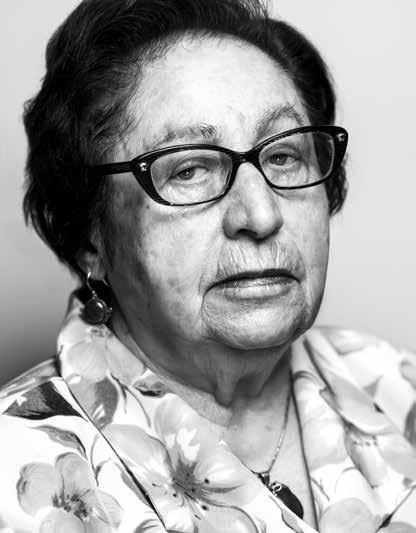
Mum was born in Sosnowiec, Poland on 26 August, 1924. From 1942 until her liberation on 8 May 1945 mum was in the Parschnitz forced labour camp in Czechoslovakia. During her time there, she would receive correspondence from home, including photographs which needed to be destroyed. Disobedience meant the possibility of death. Mum kept these photos in the soles of her shoes. These were the only photos of her family that survived the war.
Mum met Dad after the war in a displaced person’s camp in BergenBelsen in 1945 and they married the next year. They travelled by boat to Australia in 1949. My older brother Isaac was born in Melbourne two months after their arrival in October
1949. I arrived six and a half years later in May 1956.
Life was difficult in a strange country, but with determination and lots of effort, they made thing work. Mum was blessed with four grandchildren (“I have been blessed to attend the Bnei Mitzvot of my four grandchildren”) and five great grandchildren who all gave mum enormous nachas Being a Buba was mum’s calling. She loved spoiling the grandchildren and greatgrandchildren. For many years mum tried to learn to swim which turned out to be something she never quite mastered. It is true it is hard to swim if you don’t go more than knee deep into the water. But what she did master was watching her children, grandchildren and great-grandchildren swimming.
This gave her great pleasure as long as she stayed far enough way to ensure she didn’t get wet from the splashing.
Soon after the MHM opened, mum started working there as a volunteer guide. Many school groups came through and were touched by her story. Often, they would become very emotional and end up in tears. Mum encouraged them to ask questions and received many letters from students saying how significant the visit was. Her message to the students was optimistic and positive: “There are more good people than bad people in the world, and each and every one of us can make a difference.”
This is more pertinent now than it has ever been since the Shoah
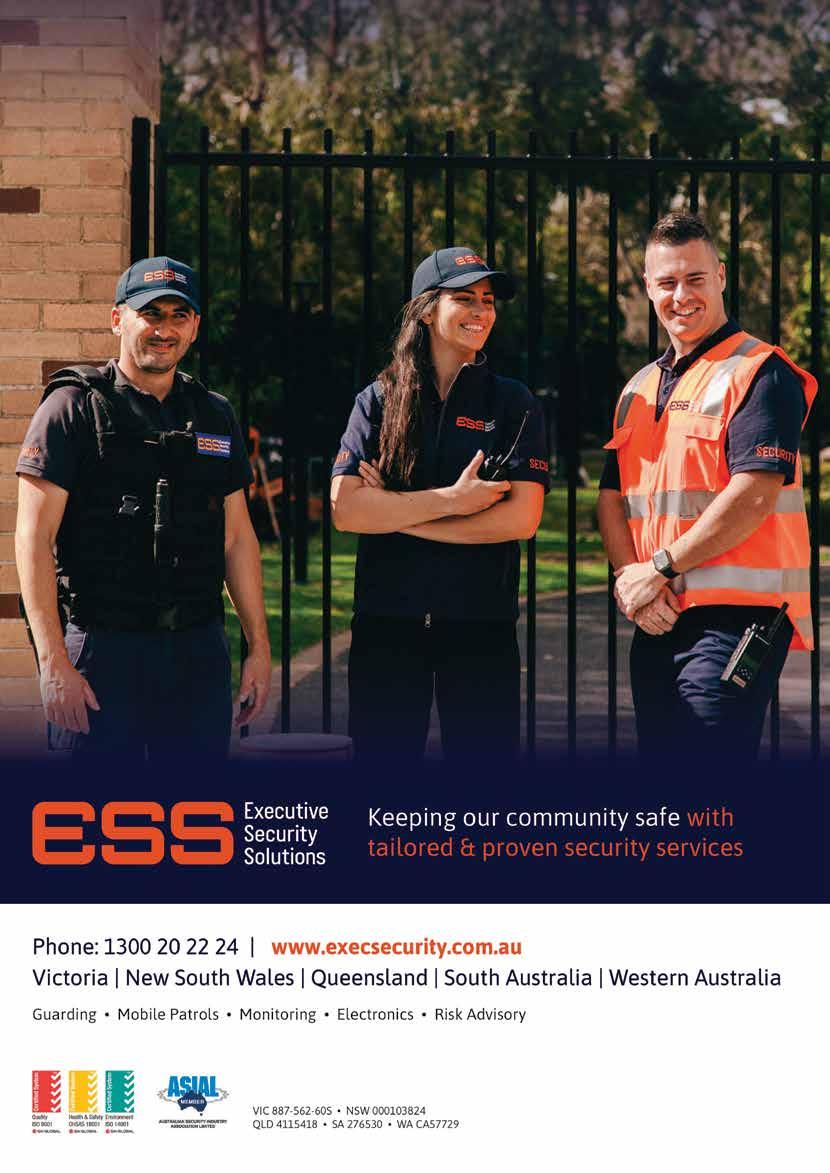


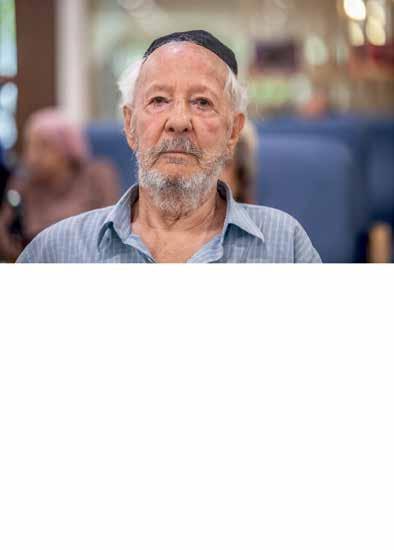
Jewish Care provides services and financial assistance to support Holocaust survivors living independently in the community.*
A range of services are available including:
•Domestic and personal care
•Financial assistance
•Restitution support
*Services funded by the Claims Conference are subject to eligibility criteria. We will help you determine your eligibility for any funded supports.
For more information, contact (03) 8517 5999 email info@jewishcare.org.au or visit jewishcare.org.au
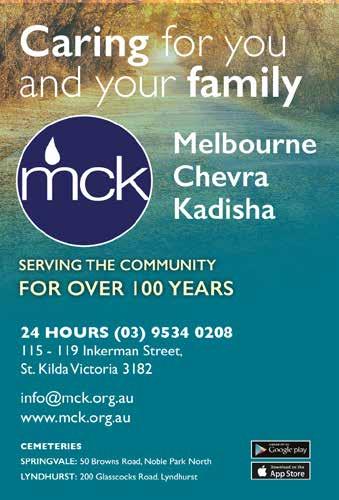

A family business, and a story of survival.
Making women look good and feel fabulous for 55 years.
Proudly supporting Melbourne Holocaust Museum fellahamilton.com.au
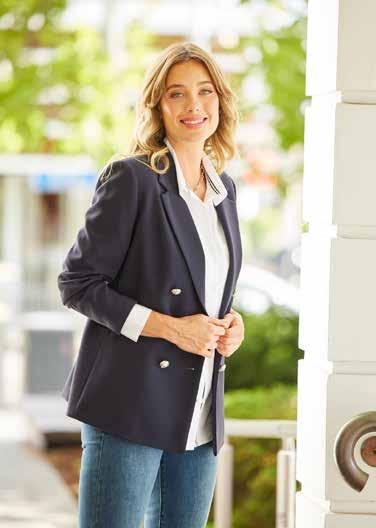


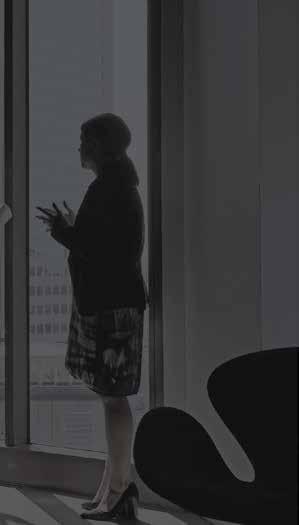
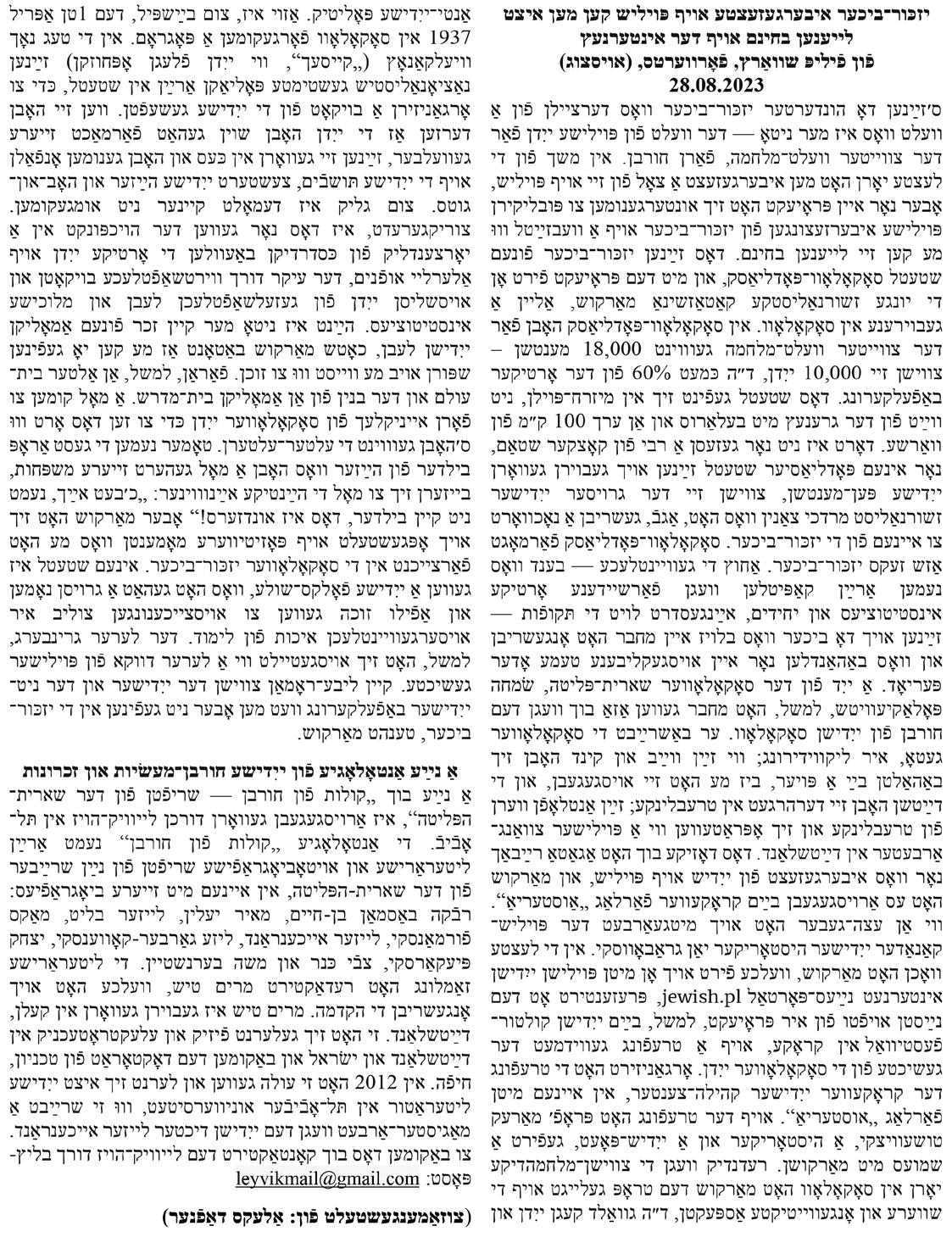
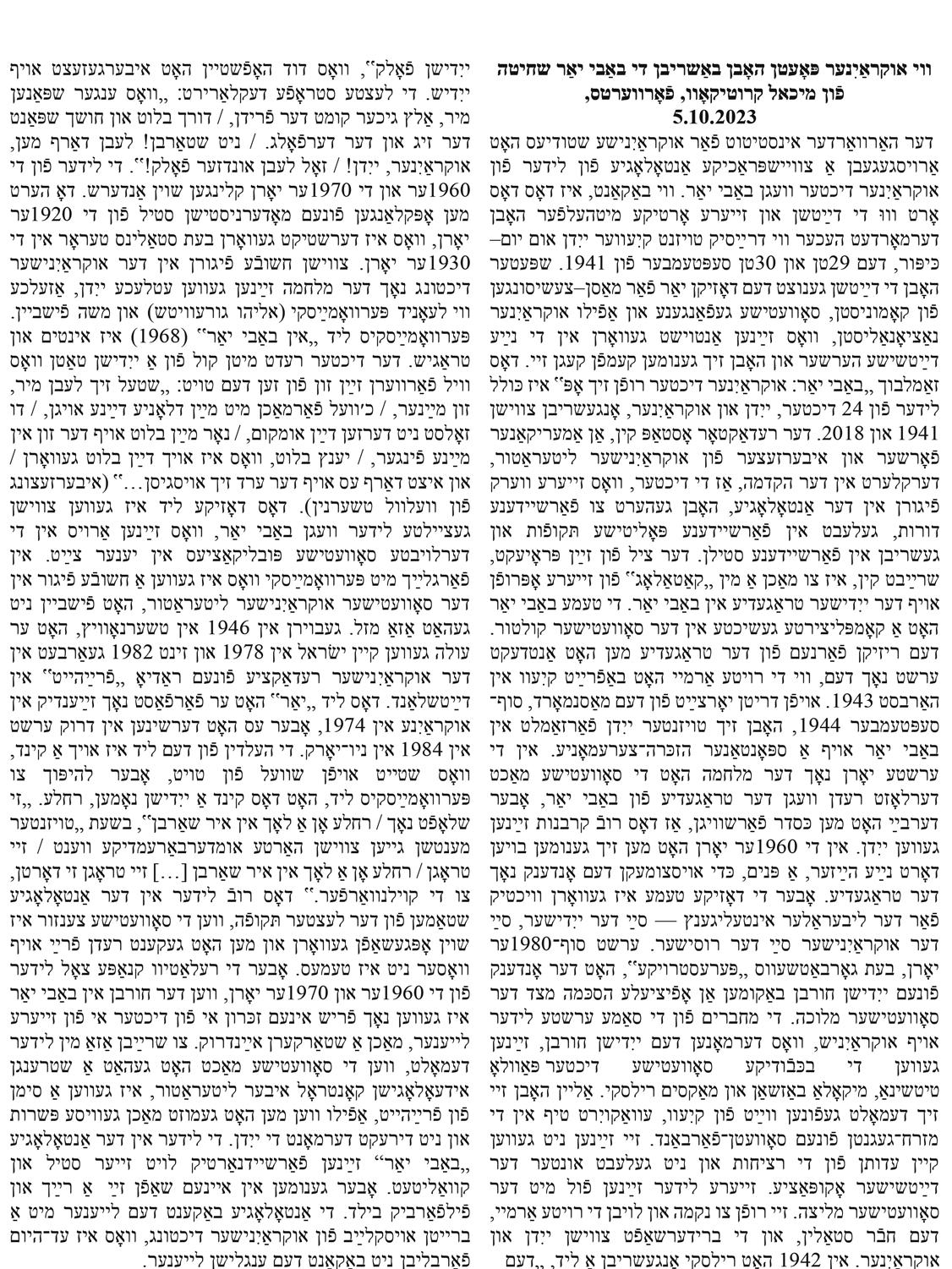
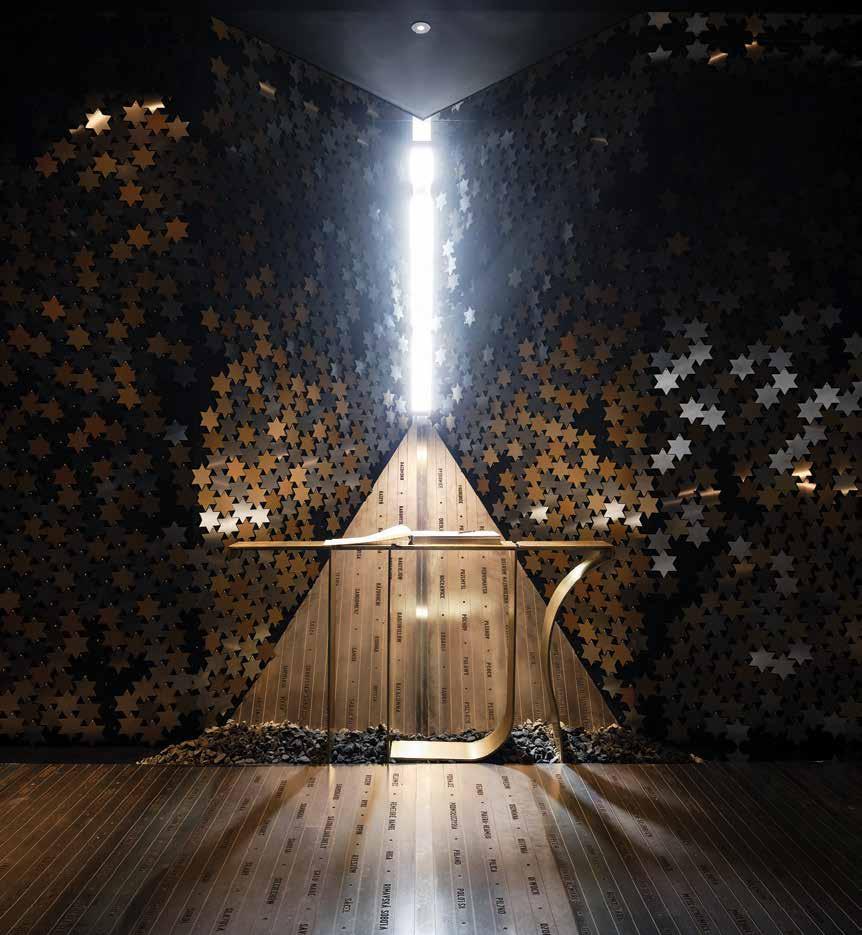

Eternalise your loved one at MHM by donating a memorial-star plaque today.
mhm.org.au/memorialise/
The MHM Memorial Room. Photographed by Simon Shiff.